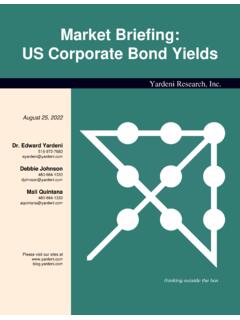Transcription of Aswath Damodaran INVESTMENT VALUATION: SECOND …
1 Aswath Damodaran INVESTMENT valuation : SECOND EDITION Chapter 1: Introduction to valuation 3 Chapter 2: Approaches to valuation 16 Chapter 3: Understanding Financial Statements 37 Chapter 4: The Basics of Risk 81 Chapter 5: Option Pricing Theory and Models 121 Chapter 6: Market Efficiency: Theory and Models 152 Chapter 7: Riskless Rates and Risk Premiums 211 Chapter 8: Estimating Risk Parameters and Costs of Financing 246 Chapter 9: Measuring Earnings 311 Chapter 10: From Earnings to Cash Flows 341 Chapter 11: Estimating Growth 373 Chapter 12: Closure in valuation : Estimating Terminal Value 425 Chapter 13: Dividend Discount Models 450 Chapter 14: Free Cashflow to Equity Models 487 Chapter 15: Firm valuation : Cost of Capital and APV Approaches 533 Chapter 16: Estimating Equity Value Per Share 593 Chapter 17: Fundamental Principles of Relative valuation 637 Chapter 18: Earnings Multiples 659 Chapter 19: Book Value Multiples 718 Chapter 20: Revenue and Sector-Specific Multiples 760 Chapter 21: Valuing Financial Service Firms 802 Chapter 22: Valuing Firms with Negative Earnings 847 Chapter 23: Valuing Young and Start-up Firms 891 Chapter 24: Valuing Private Firms 928 Chapter 25:Acquisitions and Takeovers 969 Chapter 26: Valuing Real Estate 1028 Chapter 27: Valuing Other Assets 1067 Chapter 28: The Option to Delay and valuation Implications 1090 Chapter 29: The Option to Expand and Abandon: valuation Implications 1124 Chapter 30: Valuing Equity in Distressed Firms 1155 Chapter 31: Value Enhancement: A Discounted Cashflow Framework 1176 Chapter 32: Value Enhancement: EVA, CFROI and Other Tools 1221 Chapter 33.
2 Valuing Bonds 1256 Chapter 34: Valuing Forward and Futures Contracts 1308 Chapter 35: Overview and Conclusions 1338 References 1359 1 CHAPTER 17 FUNDAMENTAL PRINCIPLES OF RELATIVE valuation In discounted cash flow valuation , the objective is to find the value of assets, given their cash flow, growth and risk characteristics. In relative valuation , the objective is to value assets, based upon how similar assets are currently priced in the market. While multiples are easy to use and intuitive, they are also easy to misuse. Consequently, a series of tests will be developed in this chapter that can be used to ensure that multiples are correctly used. There are two components to relative valuation . The first is that to value assets on a relative basis, prices have to be standardized, usually by converting prices into multiples of earnings, book values or sales.
3 The SECOND is to find similar firms, which is difficult to do since no two firms are identical and firms in the same business can still differ on risk, growth potential and cash flows. The question of how to control for these differences, when comparing a multiple across several firms, becomes a key one. Use of Relative valuation The use of relative valuation is widespread. Most equity research reports and many acquisition valuations are based upon a multiple such as a price to sales ratio or the value to EBITDA multiple and a group of comparable firms. In fact, firms in the same business as the firm being valued are called comparable, though as you see later in this chapter, that is not always true. In this section, the reasons for the popularity of relative valuation are considered first, followed by some potential pitfalls.
4 Reasons for Popularity Why is relative valuation so widely used? There are several reasons. First, a valuation based upon a multiple and comparable firms can be completed with far fewer assumptions and far more quickly than a discounted cash flow valuation . SECOND , a relative valuation is simpler to understand and easier to present to clients and customers than a discounted cash flow valuation . Finally, a relative valuation is much more likely to reflect the current mood of the market, since it is an attempt to measure relative and not intrinsic value. Thus, in a market where all internet stocks see their prices bid up, relative valuation is likely to yield higher values for these stocks than discounted cash flow 2 valuations. In fact, relative valuations will generally yield values that are closer to the market price than discounted cash flow valuations.
5 This is particularly important for those whose job it is to make judgments on relative value and who are themselves judged on a relative basis. Consider, for instance, managers of technology mutual funds. These managers will be judged based upon how their funds do relative to other technology funds. Consequently, they will be rewarded if they pick technology stocks that are under valued relative to other technology stocks, even if the entire sector is over valued. Potential Pitfalls The strengths of relative valuation are also its weaknesses. First, the ease with which a relative valuation can be put together, pulling together a multiple and a group of comparable firms, can also result in inconsistent estimates of value where key variables such as risk, growth or cash flow potential are ignored. SECOND , the fact that multiples reflect the market mood also implies that using relative valuation to estimate the value of an asset can result in values that are too high, when the market is over valuing comparable firms, or too low, when it is under valuing these firms.
6 Third, while there is scope for bias in any type of valuation , the lack of transparency regarding the underlying assumptions in relative valuations make them particularly vulnerable to manipulation. A biased analyst who is allowed to choose the multiple on which the valuation is based and to choose the comparable firms can essentially ensure that almost any value can be justified. Standardized Values and Multiples The price of a stock is a function both of the value of the equity in a company and the number of shares outstanding in the firm. Thus, a stock split that doubles the number of units will approximately halve the stock price. Since stock prices are determined by the number of units of equity in a firm, stock prices cannot be compared across different firms. To compare the values of similar firms in the market, you need to standardize the values in some way.
7 Values can be standardized relative to the earnings firms generate, to the book value or replacement value of the firms themselves, to the revenues that firms generate or to measures that are specific to firms in a sector. 1. Earnings Multiples3 One of the more intuitive ways to think of the value of any asset is the multiple of the earnings that asset generates. When buying a stock, it is common to look at the price paid as a multiple of the earnings per share generated by the company. This price/earnings ratio can be estimated using current earnings per share, yielding a current PE, earnings over the last 4 quarters, resulting in a trailing PE, or an expected earnings per share in the next year, providing a forward PE. When buying a business, as opposed to just the equity in the business, it is common to examine the value of the firm as a multiple of the operating income or the earnings before interest, taxes, depreciation and amortization (EBITDA).
8 While, as a buyer of the equity or the firm, a lower multiple is better than a higher one. These multiples will be affected by the growth potential and risk of the business being acquired. 2. Book Value or Replacement Value MultiplesWhile markets provide one estimate of the value of a business, accountants often provide a very different estimate of the same business. The accounting estimate of book value is determined by accounting rules and is heavily influenced by the original price paid for assets and any accounting adjustments (such as depreciation) made since. Investors often look at the relationship between the price they pay for a stock and the book value of equity (or net worth) as a measure of how over- or undervalued a stock is; the price/book value ratio that emerges can vary widely across industries, depending again upon the growth potential and the quality of the investments in each.
9 When valuing businesses, you estimate this ratio using the value of the firm and the book value of all assets (rather than just the equity). For those who believe that book value is not a good measure of the true value of the assets, an alternative is to use the replacement cost of the assets; the ratio of the value of the firm to replacement cost is called Tobin s Q. 3. Revenue MultiplesBoth earnings and book value are accounting measures and are determined by accounting rules and principles. An alternative approach, which is far less affected by accounting choices, is to use the ratio of the value of an asset to the revenues it generates. For equity investors, this ratio is the price/sales ratio (PS), where the market value per share is divided by the revenues generated per share. For firm value, this ratio can be 4 modified as the value/sales ratio (VS), where the numerator becomes the total value of the firm.
10 This ratio, again, varies widely across sectors, largely as a function of the profit margins in each. The advantage of using revenue multiples, however, is that it becomes far easier to compare firms in different markets, with different accounting systems at work, than it is to compare earnings or book value multiples. 4. Sector-Specific MultiplesWhile earnings, book value and revenue multiples are multiples that can be computed for firms in any sector and across the entire market, there are some multiples that are specific to a sector. For instance, when Internet firms first appeared on the market in the later 1990s, they had negative earnings and negligible revenues and book value. Analysts looking for a multiple to value these firms divided the market value of each of these firms by the number of hits generated by that firm s web site.





